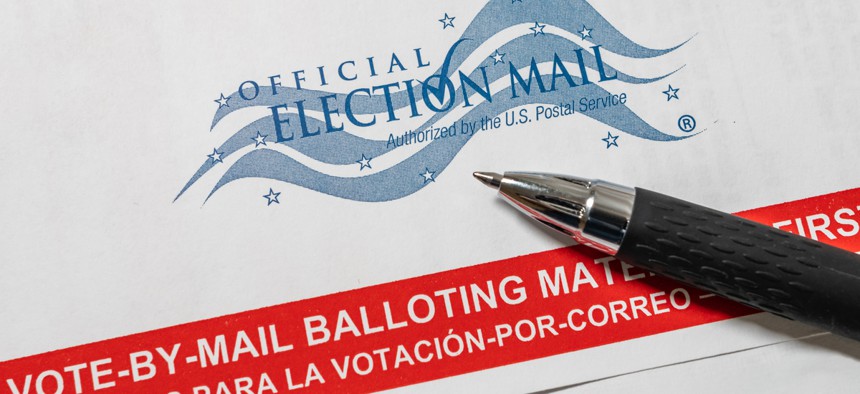We Owe It to Voters to Help Them Fix Rejected Ballots

A Florida mail-in ballot. SHUTTERSTOCK
COMMENTARY | States should provide opportunities to allow voters the opportunity to fix mistakes, or “cure,” mail-in ballots.
For the first time ever, you decide to vote by mail-in ballot.
You mark down your candidates, place the ballot in the envelope—and mail it.
Easy.
But what if you made a mistake?
Depending upon your state, mistakes can include forgetting to insert your ballot into the supplied inner envelope before returning it. Not sealing the flap. Not signing the outer envelope in front of a witness or a notary. Sometimes, the mistake might not even be yours—maybe your signature no longer matches the one on file and a poll worker rejects your ballot.
For most states, the result of any of these and other mistakes is brutally simple: your vote doesn’t count.
This isn’t an isolated situation. In a typical presidential election, approximately 0.25% of ballots are rejected. Current estimates are that 100 million people will be voting absentee or by mail in the general election. That means that a quarter of a million people’s votes may not count. Other estimates are even more dire: according to a National Public Radio report, about 550,000 mailed ballots were disqualified during primary season due to unclear or incorrect markings by the voters. If this happens again, it could be devastating to our nation’s trust in our elections.
But it doesn’t have to be this way.
The “cure,” as it is frequently called in the election community, is to notify voters and give them an opportunity to correct the issue.
Currently, 18 states have statutes that allow voters to correct signature issues. A few states have temporarily implemented partial or full cure for problems with signatures—meaning the voters are contacted and given an opportunity to either vote in person or correct their ballot.
The National Conference of State Legislatures has compiled a resource to show specifically what these states are doing. They range from giving voters the opportunity to correct their ballots to simply giving them enough warning so they can choose to vote again at the polls.
More states should take advantage of these ideas to give voters the ability to correct mistakes. Of course, every state is different, and one size doesn’t fit all. But there are basically two steps to curing mistakes in balloting.
1.Notify voters as soon as possible when they make a mistake
Once an issue is detected, rapid communication with voters is critical to making sure that they have enough time to act. For example, Iowa law requires that the commissioner of elections notify a voter if their ballot is incomplete within 24 hours of receipt.
2.Give voters an opportunity to cure their signature errors
By having a well-defined set of options, voters can choose the method most convenient for them to cure the problem. The common cures involve one or more of the following methods.
- Via affidavits
- In Utah, voters can provide the election officer a signed affidavit no later than 5 p.m. the day before the canvass.
- Send a new mail-in ballot
- Massachusetts allows voters to rectify errors by offering a substitute ballot.
- Vote in-person
- Iowa allows voters to cast a ballot on election day at the voter’s polling place.
Even now, it may be possible to implement a cure in time for the 2020 general election, via regulation or executive order. For example, in the days leading up to the Kentucky primary, Gov. Andy Beshear, a Democrat, Secretary of State Michael Adam, a Republican, and the State Board of Elections issued executive orders and regulations to implement a cure for signature mismatches, giving voters up to five days after the election to fix the signature mismatch.
Unfortunately, trust in absentee or mail-in balloting has become a partisan issue, although there is no evidence that these ballots give either party an advantage. In nine states and the District of Columbia, ballots are mailed to all voters—five of these states have conducted elections this way for more than 10 years, with a statistically irrelevant levels of fraud or compromise.
As someone who has spent much of my career in election security, I know how seriously state election officials take their roles. Now, they are facing extreme pressure from politicians and the media.
But at its core, the decision is straightforward—every voter has the right to be heard and their vote counted. It’s fundamental to our democracy.
Eighteen states have taken steps to ensure that small errors don’t silence the voices of our citizens. That leaves 32 states that can and should do more. And it’s up to the state legislatures, election officials and governors to make it happen.
We owe it to voters to offer a cure for rejected ballots.
Marc Schneider is a principal cybersecurity engineer leading election security projects at MITRE and an author of the paper Six Steps to a Safe,Trusted Election in November. The opinion expressed is the author’s and does not necessarily reflect the views of MITRE.
NEXT STORY: As Anxieties Rise, Californians Buy Hundreds of Thousands More Guns





